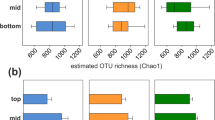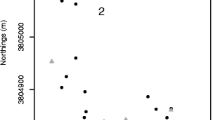Abstract
Bacterial communities associated with tree canopies have been shown to be specific to their plant hosts, suggesting that plant species-specific traits may drive the selection of microbial species that comprise their microbiomes. To further examine the degree to which the plant taxa drive the assemblage of bacterial communities in specific plant microenvironments, we evaluated bacterial community structures associated with the phyllosphere, dermosphere, and rhizosphere of seven tree species representing three orders, four families and four genera of plants from a pristine Dense Ombrophilous Atlantic forest in Brazil, using a combination of PCR-DGGE of 16S rRNA genes and clone library sequencing. Results indicated that each plant species selected for distinct bacterial communities in the phyllosphere, dermosphere, and rhizosphere, and that the bacterial community structures are significantly related to the plant taxa, at the species, family, and order levels. Further characterization of the bacterial communities of the phyllosphere and dermosphere of the tree species showed that they were inhabited predominantly by species of Gammaproteobacteria, mostly related to Pseudomonas. In contrast, the rhizosphere bacterial communities showed greater species richness and evenness, and higher frequencies of Alphaproteobacteria and Acidobacteria Gp1. With individual tree species each selecting for their specific microbiomes, these findings greatly increase our estimates of the bacterial species richness in tropical forests and provoke questions concerning the ecological functions of the microbial communities that exist on different plant parts.

Similar content being viewed by others
References
Lambais MR, Crowley DE, Cury JC et al (2006) Bacterial diversity in tree canopies of the Atlantic forest. Science 312:1917. doi:10.1126/science.1124696
Redford AJ, Bowers RM, Knight R et al (2010) The ecology of the phyllosphere: geographic and phylogenetic variability in the distribution of bacteria on tree leaves. Environ Microbiol 12:2885–2893. doi:10.1111/j.1462-2920.2010.02258.x
Kim M, Singh D, Lai-Hoe A et al (2012) Distinctive phyllosphere bacterial communities in tropical trees. Microb Ecol 63:674–681. doi:10.1007/s00248-011-9953-1
Savoia D (2012) Plant-derived antimicrobial compounds: alternatives to antibiotics. Future Microbiol 7:979–990. doi:10.2217/fmb.12.68
Dicke M (2000) Chemical ecology of host-plant selection by herbivorous arthropods: a multitrophic perspective. Biochem Syst Ecol 28:601–617
Treutter D (2006) Significance of flavonoids in plant resistance: a review. Environ Chem Lett 4:147–157. doi:10.1007/s10311-006-0068-8
Bulgarelli D, Schlaeppi K, Spaepen S et al (2013) Structure and functions of the bacterial microbiota of plants. Annu Rev Plant Biol 64:807–838. doi:10.1146/annurev-arplant-050312-120106
Rønsted N, Symonds MRE, Birkholm T et al (2012) Can phylogeny predict chemical diversity and potential medicinal activity of plants? A case study of Amaryllidaceae. BMC Evol Biol 12:182. doi:10.1186/1471-2148-12-182
Ribeiro MC, Metzger JP, Martensen AC et al (2009) The Brazilian Atlantic forest: how much is left, and how is the remaining forest distributed? Implications for conservation. Biol Conserv 142:1141–1153. doi:10.1016/j.biocon.2009.02.021
Øvreås L, Forney L, Daae FL (1997) Distribution of bacterioplankton in meromictic lake Sælenvannet, as determined by denaturing gradient gel electrophoresis of PCR-amplified gene fragments coding for 16S rRNA. Microbiology 63:3367–3373
Oksanen J, Blanchet FG, Legendre P et al (2013) Package “Vegan” 2.0-10 [Documentation File]. http://cran.r-project.org/web/packages/vegan/index.html. Accessed 14 Jan 2014
Legendre P, Gallagher E (2001) Ecologically meaningful transformations for ordination of species data. Oecologia 129:271–280. doi:10.1007/s004420100716
Marchesi JR, Sato T, Weightman AJ et al (1998) Design and evaluation of useful bacterium-specific PCR primers that amplify genes coding for bacterial 16S rRNA. Appl Environ Microbiol 64:795–799
Ewing B, Green P (1998) Base-calling of automated sequencer traces using Phred. II. Error probabilities. Genome Res 8:186–194
Schloss PD, Westcott SL, Ryabin T et al (2009) Introducing MOTHUR: open-source, platform-independent, community-supported software for describing and comparing microbial communities. Appl Environ Microbiol 75:7537–7541. doi:10.1128/AEM.01541-09
Quast C, Pruesse E, Yilmaz P et al (2013) The SILVA ribosomal RNA gene database project: improved data processing and web-based tools. Nucleic Acids Res 41:D590–D596. doi:10.1093/nar/gks1219
Wang Q, Garrity GM, Tiedje JM, Cole JR (2007) Naive Bayesian classifier for rapid assignment of rRNA sequences into the new bacterial taxonomy. Appl Environ Microbiol 73:5261–5267. doi:10.1128/AEM.00062-07
Qvit-Raz N, Finkel OM, Al-Deeb TM et al (2012) Biogeographical diversity of leaf-associated microbial communities from salt-secreting Tamarix trees of the Dead Sea region. Res Microbiol 163:142–150. doi:10.1016/j.resmic.2011.11.006
Finkel OM, Burch AY, Elad T et al (2012) Distance-decay relationships partially determine diversity patterns of phyllosphere bacteria on Tamarix trees across the Sonoran Desert [corrected]. Appl Environ Microbiol 78:6187–6193. doi:10.1128/AEM.00888-12
Martins G, Lauga B, Miot-Sertier C et al (2013) Characterization of epiphytic bacterial communities from grapes, leaves, bark and soil of grapevine plants grown, and their relations. PLoS ONE 8:e73013. doi:10.1371/journal.pone.0073013
Courtois EA, Baraloto C, Paine CET et al (2012) Differences in volatile terpene composition between the bark and leaves of tropical tree species. Phytochemistry 82:81–88. doi:10.1016/j.phytochem.2012.07.003
Sandhu A, Halverson LJ, Beattie GA (2007) Bacterial degradation of airborne phenol in the phyllosphere. Environ Microbiol 9:383–392. doi:10.1111/j.1462-2920.2006.01149.x
Berg G, Smalla K (2009) Plant species and soil type cooperatively shape the structure and function of microbial communities in the rhizosphere. FEMS Microbiol Ecol 68:1–13. doi:10.1111/j.1574-6941.2009.00654.x
Lundberg DS, Lebeis SL, Paredes SH et al (2012) Defining the core Arabidopsis thaliana root microbiome. Nature 488:86–90. doi:10.1038/nature11237
Bulgarelli D, Rott M, Schlaeppi K et al (2012) Revealing structure and assembly cues for Arabidopsis root-inhabiting bacterial microbiota. Nature 488:91–95. doi:10.1038/nature11336
Vorholt JA (2012) Microbial life in the phyllosphere. Nat Rev Microbiol 10:828–840. doi:10.1038/nrmicro2910
Whipps JM, Hand P, Pink D, Bending GD (2008) Phyllosphere microbiology with special reference to diversity and plant genotype. J Appl Microbiol 105:1744–1755. doi:10.1111/j.1365-2672.2008.03906.x
Hol WHG, Bezemer TM, Biere A (2013) Getting the ecology into interactions between plants and the plant growth-promoting bacterium Pseudomonas fluorescens. Front Plant Sci 4:81. doi:10.3389/fpls.2013.00081
Shen X, Hu H, Peng H et al (2013) Comparative genomic analysis of four representative plant growth-promoting rhizobacteria in Pseudomonas. BMC Genomics 14:271. doi:10.1186/1471-2164-14-271
Delmotte N, Knief C, Chaffron S et al (2009) Community proteogenomics reveals insights into the physiology of phyllosphere bacteria. Proc Natl Acad Sci U S A 106:16428–16433. doi:10.1073/pnas.0905240106
Burch AY, Zeisler V, Yokota K et al (2014) The hygroscopic biosurfactant syringafactin produced by P. syringae enhances fitness on leaf surfaces during fluctuating humidity. Environ Microbiol. doi:10.1111/1462-2920.12437
Berendsen RL, Pieterse CMJ, Bakker PAHM (2012) The rhizosphere microbiome and plant health. Trends Plant Sci 17:478–486. doi:10.1016/j.tplants.2012.04.001
Myers N, Mittermeier RA, Mittermeier CG et al (2000) Biodiversity hotspots for conservation priorities. Nature 403:853–858. doi:10.1038/35002501
Acknowledgments
We thank Ricardo Ribeiro Rodrigues for coordinating the Biota project, Gerd Sparovek for contribution and discussion of ideas, Geraldo Franco for assistance in identifying the tree species, Marianna Giannoti and Natalia Ivanauskas for logistical support, and Robinson M. Andrade and Rafael D. Armas for helping with sample and data analyses. This project was supported by BIOTA-FAPESP (São Paulo Research Foundation, São Paulo, Brazil).
Author information
Authors and Affiliations
Corresponding authors
Additional information
The nucleotide sequence data reported are available in the GenBank databases under the accession numbers KC745794-KC746536, KC742543-KC743241, and KC744053-KC745793.
Electronic supplementary material
Below is the link to the electronic supplementary material.
ESM 1
(PDF 2.47 MB)
Rights and permissions
About this article
Cite this article
Lambais, M.R., Lucheta, A.R. & Crowley, D.E. Bacterial Community Assemblages Associated with the Phyllosphere, Dermosphere, and Rhizosphere of Tree Species of the Atlantic Forest are Host Taxon Dependent. Microb Ecol 68, 567–574 (2014). https://doi.org/10.1007/s00248-014-0433-2
Received:
Accepted:
Published:
Issue Date:
DOI: https://doi.org/10.1007/s00248-014-0433-2




